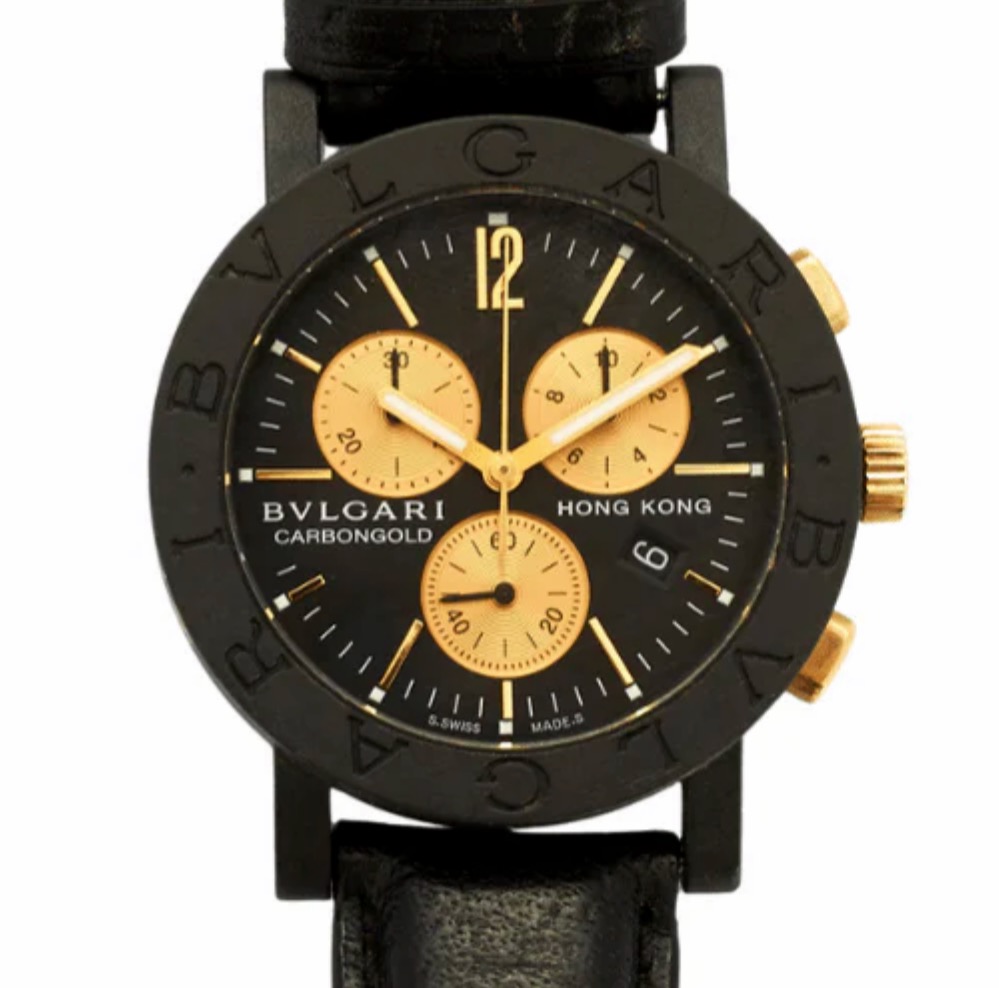

Title: Rare Bvlgari Carbon Gold Hong Kong Limited Edition Watch
Shipping: $29.00
Artist: N/A
Period: Contemporary
History: Art
Origin: Southern Europe > Italy
Condition: Excellent
Item Date: N/A
Item ID: 110
Mint Condition Bvlgari Limited Edition Carbon Gold Chronograph We are offering this Bvlgari Limited Edition Carbon Gold Chronograph below its market value. This unisex watch, produced between 2000-2010, is a rare piece from a limited series of only 999 units. Details: Model: Bvlgari Carbon Gold Chronograph, signed Bvlgari, Hong Kong Limited Edition - BB 38 CL CH Edition: Watch No. 377/999 Condition: Mint, requires a battery replacement Casing: Black carbon with a gold bezel featuring the Bvlgari logotype Size: Approximately 38mm Glass: Sapphire crystal Movement: Quartz, ETA 215.471, 23 jewels Dial: Black with gold sub-dials for constant seconds, minute, and hour registers; luminous gold hands and bar markers Case Back: Secured by gold screws, with a gold plaque engraved with "377/999" on the side Crown and Push Buttons: Gold Strap: Original leather with carbon buckle and gold tang Signature: All components signed Bvlgari, Hong Kong on the dial Includes: Original box and complete papers About Bvlgari: Bvlgari, renowned for its luxurious jewelry and timepieces, launched the BVLGARI BVLGARI watch in 1977, marking its entry into horology. In the early 1980s, Bvlgari Time was established in Switzerland to oversee all watch production. The company expanded its expertise by acquiring luxury watchmaking brands Daniel Roth and Gérald Genta, as well as the jewelry firm Crova. Bvlgari's watch collections include Octo, BVLGARI BVLGARI, Diagono, and Haute Horlogerie for men, alongside LVCEA, Serpenti, Divas’ Dream, B.zero1, and High Jewellery timepieces for women. The company blends Italian design with Swiss craftsmanship, with production managed by Bulgari Haute Horlogerie SA, founded in 1980 and headquartered in Neuchâtel, Switzerland. In the 1950s, Bvlgari became a favorite among Hollywood stars like Elizabeth Taylor, Anna Magnani, Ingrid Bergman, and Gina Lollobrigida, as Rome gained fame as "Hollywood on the Tiber." During this period, Bvlgari introduced new styles, focusing on precious materials and innovative designs, such as their famous en tremblant brooches with trembling diamond corollas and their signature use of yellow gold with brilliant gems.
Type: Bvlgari Limited Edition Carbon Gold Cronograph, Hong Kong, 377/999 Model: BB 38 CL CH Dial: black and gold, gold bar markers Hands; luminous gold batons Metal: carbon and gold Case Info: back secured by gold screws Case Width: 38 mm Crystal: sapphire Watch Movement: 23 jewels, quartz, ETA 251.471 Band: leather, carbon buckle with gold tang Circa: 2000 Condition: near new, with box, booklet *The gallery guarantees In stands by their collectibles 100%. The gallery always seeks out expert's opinions. *Statements by Busacca Gallery regarding the condition of objects are for guidance only and should not be relied upon as statements of fact, and do not constitute a representation, warranty, or assumption of liability by Busacca Gallery. Another words all buyers must do their homework and the gallery recommends seek out a second opinion.
Link: https://en.wikipedia.org/wiki/Bulgari
BVLGARI) is an Italian luxury brand known for its jewellery, watches, fragrances, accessories and leather goods. Bulgari was founded in the region of Epirus, Greece, in 1884 by the silversmith Sotirios Boulgaris (Italian: Sotirio Bulgari) as a single jewellery shop that has, over the years, become an international brand. The company has evolved into a player in the luxury market, with an established and growing network of stores. The Voulgaris were a silversmithing family from the Epirus region of [Greece]]. Whether or not the Voulgaris family of Corfu and the Voulgaris family of the Italian jewelers Bulgari from Epirus share the same paternal line is unclear, but the count Stefanos Voulgaris denied that the Bulgari family of the Italian jewelers family is genealogically related to the Voulgaris family of Corfu. According to chronicles of the Voulgaris family written in Venetian Corfu, the "Voulgaris family of Saint Spyridon of Corfu" descend from the royal figures of barbarian peoples from the Volga river, who "finally settled in Moesia near the Haemus mountains, located in Bulgaria", so the founding father of this family was described as the "Triballian" (de facto Serbian) Prince Stefan Lazarevic in the 16th century testemant of the family, becoming such by taking refugee in the Venetian island Corfu. The founder of the Bulgari brand is Sotirios Voulgaris who was born in March 1857 and came from the Epirus Village of Paramythia, the largest Aromanian center of silversmithing in the Balkans. He was one of eleven children of his father Georgios Voulgaris(1823–1889) and his Aromanian mother Eleni Stronggaris. In 1881, Sotirios Bulgari moved to Rome and, in 1884, opened his first store on via Sistina 85. In 1888, he married Aromanian Eleni Basio with whom he had six children: Constantine–Georgios(1889–1973), Leonidas–Georgios(1890–1966), Maria–Athena(1891–1976), Sofia(1893–1908), Alexandra(1895–1984) and Spyridon(1897–1932); Leonidas–Georgios is the father of the current chairman of the company, Paolo Bulgari. In 1905, he unveiled the Via Condotti shop that would become the company’s flagship. In its early years, Bulgari was known for silver pieces that borrowed elements from Byzantine and Islamic art, combining them with floral motifs. At the time, Paris was the apex of fashion and creativity, and its trends influenced Sotirio’s designs for decades: jewels of the early 20s were characterised by platinum Art Deco settings while those of the 30s featured geometric diamond motifs—sometimes set in combination with coloured gemstones. Convertible jewels were also popular during the time, and one of Bulgari’s major piece was the Trombino, a small trumpet–shaped ring. In 1932 Sotirio died, leaving the business to his two sons, Giorgio (1890–1966) and Costantino (1889–1973), who each had a keen interest in precious stones and jewels. During the Second World War, most new jewellery was crafted out of gold, as gems were scarce, and designs became more natural feeling. As the 1940s came to a close, Bulgari introduced Serpenti bracelet–watches.